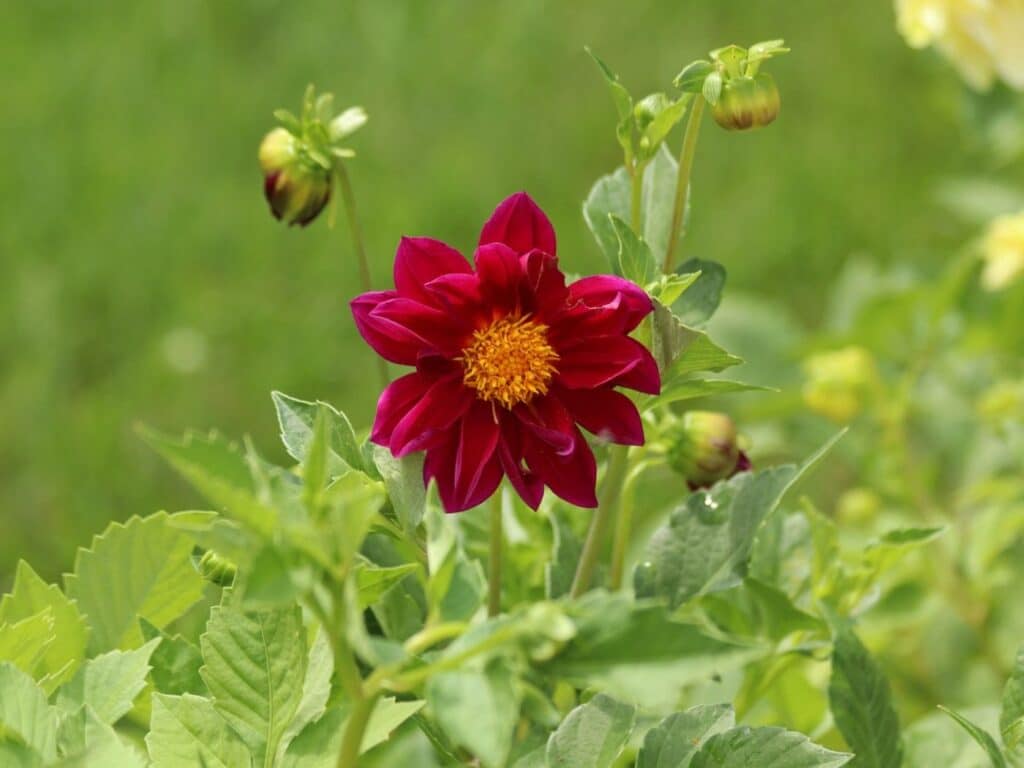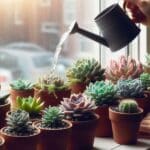Discovering your dahlia’s leaves turning yellow can be disheartening, especially when you’ve invested time and effort into nurturing these vibrant blooms. This common gardening challenge can leave you puzzled, wondering where you may well have gone wrong.
However, it’s crucial to understand that yellowing leaves are a sign your dahlias are trying to tell you something. Whether it’s a call for nutrients, a plea for water, or a cry for help against disease, decoding the message is key to reviving your plants.
Fear not, for this issue is often reversible with the right knowledge and approach. In the following sections, we’ll explore the various causes of yellowing dahlia leaves and provide you with actionable solutions to restore your garden’s health and vibrancy.
Let’s embark on this journey together, turning your gardening woes into a flourishing success.
Understanding Why Dahlia Leaves Turn Yellow
The Role of Nutrient Deficiencies
Nutrient deficiencies play a significant part in why dahlia leaves may well turn yellow. Just like you feel a bit off when you’re not eating right, dahlias react similarly when they lack certain nutrients.
Nitrogen, potassium, and iron are the usual suspects. If your dahlias are showing yellow leaves, consider if the soil may well be missing these key nutrients. A soil test can reveal a lot and help guide your fertilization plan to get your dahlias back to their vibrant selves.
Watering Practices and Their Effects
Getting the water balance right is critical for dahlias. Too much or too little can send them into a yellowing spiral. Over-watering can suffocate the roots, preventing proper absorption of nutrients and leading to yellow leaves.
On the flip side, under-watering stresses the plant, which also causes yellowing. The trick is to maintain consistent moisture, especially during dry spells. A good rule of thumb is to check the soil’s moisture level a few inches down; if it’s dry, it’s time to water.
Light Exposure and Plant Health
Sunlight is to plants what coffee is to humans; they need it to kickstart their day. Dahlias thrive in full sun but can show signs of stress, like yellowing leaves, when they get too much or too little light.
If your dahlias aren’t getting at least six hours of sunlight a day, consider moving them to a sunnier spot. Conversely, if scorching summers are causing the leaves to yellow and wilt, providing some afternoon shade could be the remedy. Balancing light exposure ensures your dahlias remain healthy and colorful.
Common Diseases Affecting Dahlias
Understanding the common diseases that lead to dahlia leaves turning yellow can significantly impact your gardening success. Let’s dive into the two primary culprits: fungal and viral/bacterial challenges.
Fungal Infections and Yellow Leaves
Fungal infections take the cake when it comes to reasons why your dahlia leaves may well start resembling slices of lemon. Powdery mildew and verticillium wilt top the list, thriving in conditions that are too moist or lack proper air circulation.
If your dahlias are looking a bit pale, it’s a good idea to check for a powdery substance on the leaves or stems that wilt without reason. Adjusting watering practices and ensuring good airflow around your plants can be game changers in managing these fungal foes.
Viral and Bacterial Challenges
Conversely, viruses and bacteria bring their own set of challenges to the dahlia garden party. Dahlia mosaic virus, characterized by mottled yellow leaves, is a common uninvited guest. Similarly, bacterial wilt can cause your dahlias to droop as if they’ve lost their zest for life.
Unfortunately, with viruses and bacteria, the best offense is a good defense. Selecting resistant varieties and practicing clean gardening by removing affected plants promptly will help keep your garden healthy.
Remember, keeping an eye out for these issues and acting quickly when you spot them is key to making sure your dahlias stay as vibrant as ever.
Environmental Factors Contributing to Yellowing Leaves
Soil Quality and pH Levels
Soil isn’t just dirt; it’s the dining room for your dahlias. If the soil quality isn’t up to par or the pH levels are out of whack, your dahlias will send an RSVP in the form of yellow leaves. Dahlias thrive in soils that are fertile and well-drained, with a pH level ranging ideally between 6.5 and 7.0.
Testing your soil can reveal a lot. If the pH isn’t in the sweet spot, it’s like serving a gourmet meal on a trash can lid—not quite right. Adjusting soil acidity or alkalinity can sometimes feel like chemistry class, but it’s crucial for preventing those yellow leaves.
Extreme Weather Conditions
Dahlias are a bit like Goldilocks—not too hot, not too cold. Extreme temperatures can stress them out, leading to yellow leaves. Intense heat, especially combined with drought, can scorch leaves, turning them yellow or brown. On the flip side, unusually cold weather can cause leaf discoloration as well.
Dahlias prefer their environment just right, with moderate temperatures and consistent moisture. Think of them as enjoying a spa day, every day. When weather extremes hit, providing some shade or extra water can help your dahlias bounce back to their vibrant selves.
Care Tips for Preventing Yellow Leaves

Proper Fertilization Techniques
Fertilizing your dahlias isn’t about dumping a bunch of food on them and calling it a day. Instead, think about giving them a balanced diet. Aim for a fertilizer that offers a mix of nitrogen, phosphorous, and potassium, often displayed as a N-P-K ratio on the packaging.
A 10-10-10 mix applied once at planting and again as flowers start to form ensures they get what they need without going overboard. Remember, too much love in the form of fertilizer can actually push your dahlias towards yellow leaf lane.
Optimizing Watering Schedules
Watering your dahlias is less about sticking to a rigid schedule and more about observing their needs. These plants enjoy consistent moisture but detest soggy feet. Therefore, aim for about 1 inch of water per week, whether from rain or your hose, allowing the top inch of soil to dry out between waterings.
If the forecast calls for a heatwave or your dahlias are in pots, they’ll likely need a bit more H2O to keep their cool. An early morning watering routine can reduce evaporation and prevent fungal diseases by keeping the leaves dry by nightfall.
Managing Sunlight and Shade
Dahlias thrive in the sunshine but can have too much of a good thing. They prefer a sunny spot that gets at least 6 hours of direct sunlight daily. However, in areas where the sun blazes like there’s no tomorrow, providing some afternoon shade can prevent their leaves from throwing a yellow flag.
If your garden lacks natural shade, consider using a cloth or planting taller plants to cast a protective shadow during the peak hours of sunlight. This way, your dahlias get the light they love without the stress that turns their leaves yellow.
When to Seek Professional Help
Identifying When Yellowing Is a Serious Issue
Yellow leaves can be a headache, signaling your dahlias are unhappy. But, how do you know when it’s just a minor glitch or a call to arms? Here’s the scoop: if yellow leaves persist despite your best efforts, you may well be dealing with a severe issue.
Diseases like verticillium wilt, nematode infestations, or root rot do more than just discolour leaves – they attack your plants’ very core. If you notice stunted growth, wilting, or extensive leaf yellowing that doesn’t improve with corrective measures, it’s time to call in the cavalry.
Resources for Professional Horticultural Advice
Finding someone who knows their stuff about dahlias can be like finding a needle in a haystack, but don’t fret. Starting with local gardening clubs or extension services is your best bet. These folks are usually plant enthusiasts eager to share wisdom or can direct you to someone who can.
Additionally, online forums and social media groups dedicated to gardening provide a wealth of knowledge and support. Just remember, the goal is healthy, vibrant dahlias, not a PhD in Plant Pathology – although, who wouldn’t want that title?
Frequently Asked Questions
Why are my dahlia leaves turning yellow?
Dahlia leaves turn yellow primarily due to nutrient deficiencies, improper watering, or insufficient light. It’s a sign from the plant that it needs better care in terms of nutrition, hydration, or lighting conditions.
Can yellow dahlia leaves become green again?
Yes, with the right care, such as adjusting water intake, ensuring proper nutrition, and providing adequate light, yellow dahlia leaves can often revert to green as the plant’s health improves.
What soil pH is best for dahlias?
Dahlias thrive in fertile, well-drained soil with a pH level between 6.5 and 7.0. Ensuring your soil has the correct pH is crucial for healthy plant growth.
How does extreme weather affect dahlia leaves?
Extreme weather, like intense heat or cold, can stress dahlias, leading to yellow leaves. Providing shade during hot weather or extra water can help the plants recover from weather-induced stress.
What should I do if changing care practices doesn’t fix the yellow leaves?
If yellow leaves persist despite adjusting care practices, seek professional help. Diseases or pest infestations might be the cause, requiring expert advice from local gardening clubs, extension services, or online gardening communities.
Up next:







